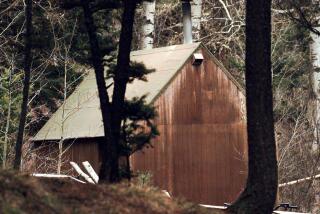Fate of Unabomber’s Cabin Still Unsettled
- Share via
SACRAMENTO — Just a month ago, Theodore Kaczynski’s grimy, wooden, one-room cabin was destined to be a critical piece of evidence in the high-profile Unabomber trial.
Now, Kaczynski has pleaded guilty to murder-by-bombing and other charges, and he will be spending the rest of his life in a federal prison, never returning to the quiet woods of Montana where he built his shack.
So, what to do with his tiny home, whose 1,100-mile journey from the Rockies was chronicled by TV and radio news crews as it journeyed aboard a flatbed truck to a warehouse at the former Mather Air Force Base near Sacramento?
Might the cabin--where Kaczynski allegedly built his bombs--be sold to defray court costs, or provide funds to bombing victims or their survivors? Could it be sold and used as a tourist attraction?
“We still don’t know. It’s still up in the air,” said Quin Denvir, Kaczynski’s lead defense attorney. “It may not be decided until after the sentencing,” now scheduled for May 15.
Denvir said there might be potential buyers for the cabin. But, he explained, even though his client owns the shack, “in the end, it will probably be up to the court. . . . It can’t be disposed of without an order of the court.”
Gary Sowards, another defense lawyer, said he couldn’t reveal what, if any, plans Kaczynski had discussed for the cabin, citing attorney-client confidentiality.
Until Kaczynski’s plea bargain last month, his lawyers had planned to use the cabin as evidence of the former UC Berkeley mathematician’s troubled mind. What sort of fellow would live for two decades in quarters not much bigger than a closet and without electricity or running water?
“In our view, the cabin symbolizes what had happened to this PhD, Berkeley professor and how he had come to live,” Denvir said in December after the cabin arrived in Sacramento. “When people think about this case, they think about the cabin.”
But a jury will never hear those points.
On Jan. 22, after weeks of legal wrangling, Kaczynski, 55, accepted a plea bargain, and prosecutors agreed to drop plans to execute the Chicago native who admitted to being the anti-technology Unabomber.
Kaczynski pleaded guilty to charges related to bombings in which three men were killed and two others seriously injured. And he took responsibility for 11 more bombings that injured 29 others in his 18-year campaign of terrorism.
Prosecutors said Kaczynski spent hours inside his cabin writing the manifesto, as well as crafting intricate bombs that he mailed to his victims. When Kaczynski was arrested in April 1996 at his shack, the FBI found a completed bomb inside ready for shipment.
Pending an evaluation by federal probation officials, Kaczynski remains in the Sacramento County Jail.
Sharon Telles, a spokeswoman for the Sacramento County Sheriff’s Department, described Kaczynski as a prolific reader and writer.
“The man reads and writes, reads and writes,” Telles said. “This man . . . he feels a need to put stuff down on paper and that’s what he does.”
Denvir acknowledged that his client writes in confinement but he discounted reports that Kaczynski, who often wrote in court on legal pads, is penning a second manifesto.
Leesa Brown, a spokeswoman for prosecutors, said the government has no say over Kaczynski’s cabin. However, she noted that victims or their families might have a claim on any profits from a sale.
The attorney for timber executive Gilbert Murray, slain by one of Kaczynski’s bombs in 1995, could not be reached for comment. The family has a civil suit pending against Kaczynski.
More to Read
Sign up for Essential California
The most important California stories and recommendations in your inbox every morning.
You may occasionally receive promotional content from the Los Angeles Times.












